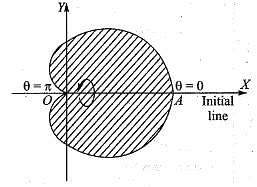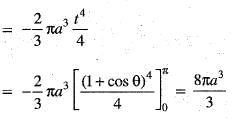Mathematics Exam > Mathematics Questions > The volume of the solid generated by the revo...
Start Learning for Free
The volume of the solid generated by the revolution of the cardioid r = a(1 + cos θ) about the initial line is given by
- a)2πa3
- b)2/3πa3
- c)4/3πa3
- d)8/3πa3
Correct answer is option 'D'. Can you explain this answer?
| FREE This question is part of | Download PDF Attempt this Test |
Verified Answer
The volume of the solid generated by the revolution of the cardioid r ...
The curve is r = a (1 + cos θ)
Required volume




Required volume




Most Upvoted Answer
The volume of the solid generated by the revolution of the cardioid r ...
The volume of the solid generated by the revolution of the cardioid r = a(1 + cos(theta)) about the x-axis can be found using the method of cylindrical shells.
First, let's express the equation of the cardioid in terms of x. We can use the equation r = a(1 + cos(theta)) and substitute x for r and theta for arccos((x/a) - 1):
x = a(1 + cos(arccos((x/a) - 1)))
x = a(1 + ((x/a) - 1))
x = a + x - a
x = x
So, the equation of the cardioid in terms of x is x = a.
Next, let's find the limits of integration. The cardioid intersects the x-axis at x = a, so the lower limit is a. The upper limit can be found by setting the equation of the cardioid equal to zero:
x = a(1 + cos(theta))
0 = a(1 + cos(theta))
1 + cos(theta) = 0
cos(theta) = -1
theta = pi
Therefore, the limits of integration are from a to pi.
Now, let's express the volume of the solid as a sum of cylindrical shells. The volume of each shell is given by the formula:
V = 2πrh * Δx
where r is the radius of the shell, h is the height of the shell, and Δx is the thickness of the shell.
The radius of each shell is equal to x, which is a constant, so r = a.
The height of each shell can be found by solving for y in terms of x:
x = a
y = a(1 + cos(theta))
y = a(1 + cos(arccos((x/a) - 1)))
y = a(1 + ((x/a) - 1))
y = x
Therefore, the height of each shell is equal to x.
The thickness of each shell is given by Δx, which is the change in x between each shell. Since x = a is a constant, Δx = 0.
Plugging these values into the volume formula, we get:
V = 2π(a)(x) * 0
Since the thickness of each shell is zero, the volume of each shell is zero. Therefore, the volume of the solid generated by the revolution of the cardioid r = a(1 + cos(theta)) about the x-axis is zero.
First, let's express the equation of the cardioid in terms of x. We can use the equation r = a(1 + cos(theta)) and substitute x for r and theta for arccos((x/a) - 1):
x = a(1 + cos(arccos((x/a) - 1)))
x = a(1 + ((x/a) - 1))
x = a + x - a
x = x
So, the equation of the cardioid in terms of x is x = a.
Next, let's find the limits of integration. The cardioid intersects the x-axis at x = a, so the lower limit is a. The upper limit can be found by setting the equation of the cardioid equal to zero:
x = a(1 + cos(theta))
0 = a(1 + cos(theta))
1 + cos(theta) = 0
cos(theta) = -1
theta = pi
Therefore, the limits of integration are from a to pi.
Now, let's express the volume of the solid as a sum of cylindrical shells. The volume of each shell is given by the formula:
V = 2πrh * Δx
where r is the radius of the shell, h is the height of the shell, and Δx is the thickness of the shell.
The radius of each shell is equal to x, which is a constant, so r = a.
The height of each shell can be found by solving for y in terms of x:
x = a
y = a(1 + cos(theta))
y = a(1 + cos(arccos((x/a) - 1)))
y = a(1 + ((x/a) - 1))
y = x
Therefore, the height of each shell is equal to x.
The thickness of each shell is given by Δx, which is the change in x between each shell. Since x = a is a constant, Δx = 0.
Plugging these values into the volume formula, we get:
V = 2π(a)(x) * 0
Since the thickness of each shell is zero, the volume of each shell is zero. Therefore, the volume of the solid generated by the revolution of the cardioid r = a(1 + cos(theta)) about the x-axis is zero.
Free Test
FREE
| Start Free Test |
Community Answer
The volume of the solid generated by the revolution of the cardioid r ...
The curve is r = a (1 + cos θ)
Required volume




Required volume





|
Explore Courses for Mathematics exam
|

|
Similar Mathematics Doubts
The volume of the solid generated by the revolution of the cardioid r = a(1 + cos θ) about the initial line is given bya)2πa3b)2/3πa3c)4/3πa3d)8/3πa3Correct answer is option 'D'. Can you explain this answer?
Question Description
The volume of the solid generated by the revolution of the cardioid r = a(1 + cos θ) about the initial line is given bya)2πa3b)2/3πa3c)4/3πa3d)8/3πa3Correct answer is option 'D'. Can you explain this answer? for Mathematics 2024 is part of Mathematics preparation. The Question and answers have been prepared according to the Mathematics exam syllabus. Information about The volume of the solid generated by the revolution of the cardioid r = a(1 + cos θ) about the initial line is given bya)2πa3b)2/3πa3c)4/3πa3d)8/3πa3Correct answer is option 'D'. Can you explain this answer? covers all topics & solutions for Mathematics 2024 Exam. Find important definitions, questions, meanings, examples, exercises and tests below for The volume of the solid generated by the revolution of the cardioid r = a(1 + cos θ) about the initial line is given bya)2πa3b)2/3πa3c)4/3πa3d)8/3πa3Correct answer is option 'D'. Can you explain this answer?.
The volume of the solid generated by the revolution of the cardioid r = a(1 + cos θ) about the initial line is given bya)2πa3b)2/3πa3c)4/3πa3d)8/3πa3Correct answer is option 'D'. Can you explain this answer? for Mathematics 2024 is part of Mathematics preparation. The Question and answers have been prepared according to the Mathematics exam syllabus. Information about The volume of the solid generated by the revolution of the cardioid r = a(1 + cos θ) about the initial line is given bya)2πa3b)2/3πa3c)4/3πa3d)8/3πa3Correct answer is option 'D'. Can you explain this answer? covers all topics & solutions for Mathematics 2024 Exam. Find important definitions, questions, meanings, examples, exercises and tests below for The volume of the solid generated by the revolution of the cardioid r = a(1 + cos θ) about the initial line is given bya)2πa3b)2/3πa3c)4/3πa3d)8/3πa3Correct answer is option 'D'. Can you explain this answer?.
Solutions for The volume of the solid generated by the revolution of the cardioid r = a(1 + cos θ) about the initial line is given bya)2πa3b)2/3πa3c)4/3πa3d)8/3πa3Correct answer is option 'D'. Can you explain this answer? in English & in Hindi are available as part of our courses for Mathematics.
Download more important topics, notes, lectures and mock test series for Mathematics Exam by signing up for free.
Here you can find the meaning of The volume of the solid generated by the revolution of the cardioid r = a(1 + cos θ) about the initial line is given bya)2πa3b)2/3πa3c)4/3πa3d)8/3πa3Correct answer is option 'D'. Can you explain this answer? defined & explained in the simplest way possible. Besides giving the explanation of
The volume of the solid generated by the revolution of the cardioid r = a(1 + cos θ) about the initial line is given bya)2πa3b)2/3πa3c)4/3πa3d)8/3πa3Correct answer is option 'D'. Can you explain this answer?, a detailed solution for The volume of the solid generated by the revolution of the cardioid r = a(1 + cos θ) about the initial line is given bya)2πa3b)2/3πa3c)4/3πa3d)8/3πa3Correct answer is option 'D'. Can you explain this answer? has been provided alongside types of The volume of the solid generated by the revolution of the cardioid r = a(1 + cos θ) about the initial line is given bya)2πa3b)2/3πa3c)4/3πa3d)8/3πa3Correct answer is option 'D'. Can you explain this answer? theory, EduRev gives you an
ample number of questions to practice The volume of the solid generated by the revolution of the cardioid r = a(1 + cos θ) about the initial line is given bya)2πa3b)2/3πa3c)4/3πa3d)8/3πa3Correct answer is option 'D'. Can you explain this answer? tests, examples and also practice Mathematics tests.

|
Explore Courses for Mathematics exam
|

|
Suggested Free Tests
Signup for Free!
Signup to see your scores go up within 7 days! Learn & Practice with 1000+ FREE Notes, Videos & Tests.


















